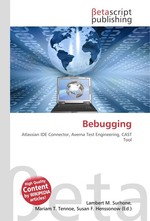Bebugging
Lambert M. Surhone, Mariam T. Tennoe, Susan F. Henssonow
бумажная книга
Please note that the content of this book primarily consists of articles available from Wikipedia or other free sources online. Bebugging (or Fault Seeding) is a popular software engineering technique used in the 70s to measure test coverage. Known bugs are randomly added to a program source code and the programmer is tasked to find them. The percentage of the known bugs not found gives an indication of the real bugs that remain. The earliest application of Bebugging was Mill's fault seeding approach which was later refined by stratified fault-seeding . These techniques worked by adding a number of known faults to a software system for the purpose of monitoring the rate of detection and removal. This assumed that it is possible to estimate the number of remaining faults in a software system still to be detected by a particular test methodology.
Данное издание не является оригинальным. Книга печатается по технологии принт-он-деманд после получения заказа.



